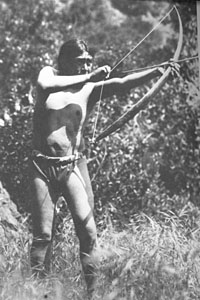The Recurve (traditional) bow

(image credit to: http://www.archeryhistory.com/archers/pics/ishi.jpg)
The recurve bow is the most simple bow. Its design has not changed much since the first bows. Any bow is basically a spring, and when the archer draws the bow, potential energy is stored in the elastically deformed bowstave. When the bowstring is let go, the potential energy is transfered to kinetic energy through the arrow.
If a graph of force, F, needed to draw an arrow back through a distance, x, the area under the graph is the work done on the system and therefore the energy stored in the bow. When the graph is a straight line through the origin (the bow acts as a spring that obeys Hooke's law), the energy will be equal to Fx/2.

(image credit to: http://www.stortford-archers.org.uk/medieval.htm)
The graph of F versus x is usually a curve, due to the shape of a bowstave (it is thickest in the middle, and thinner at the ends) and the tension in the bowstring does not always pull evenly relative to the ends of the bow. An efficiency term, e, is introduced. The total energy is written as eFx/2. Most traditional bows have an efficiency of about 0.7.
Home